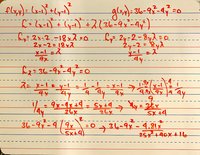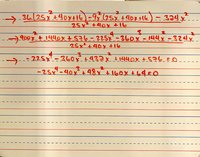hellosoupy
New member
- Joined
- Mar 28, 2021
- Messages
- 13
Hi!
This is a problem for which I have the answer in the back of the book, but I don't know how to get there.
Here is the problem:
A study conducted at a waste disposal site reveals soil contamination over a region that may be described roughly as the interior of the ellipse
[MATH]x^2/4 + y^2/9 = 1[/MATH]where x & y are in miles.
If the office at the site is at the point S(1,1), what is the radius of the smallest circle centered at S that contains the entire contaminated region?
Hint: The function
[MATH]f(x,y) = (x-1)^2 + (y-1)^2[/MATH]measures the square of the distance from S(1,1) to the point P(x,y). The required radius can be found by maximizing f(x,y) subject to a certain constraint.
My thought was to create the following Lagrangean:
[MATH]L=(x-1)^2 + (y-1)^2 + lambda*(36-9x^2-4y^2)[/MATH]
This would give
[MATH]Lx=2x-2-18x*lambda = 0[/MATH] and
[MATH]Ly=2y-2-8y*lambda = 0[/MATH]
This could be simplified to
[MATH]x(1-9*lambda) = 1[/MATH] and
[MATH]y(1-4*lambda) = 1[/MATH]
I tried to set them equal to each other and solve for y, but that gets me nowhere:
[MATH]y = x * (1-9*lambda) / (1-4*lambda)[/MATH]
Where have I gone astray?
Note: If it helps to work backwards, the answer is f(-0.49,-2.91) = 4.91 miles
Thanks in advance!
This is a problem for which I have the answer in the back of the book, but I don't know how to get there.
Here is the problem:
A study conducted at a waste disposal site reveals soil contamination over a region that may be described roughly as the interior of the ellipse
[MATH]x^2/4 + y^2/9 = 1[/MATH]where x & y are in miles.
If the office at the site is at the point S(1,1), what is the radius of the smallest circle centered at S that contains the entire contaminated region?
Hint: The function
[MATH]f(x,y) = (x-1)^2 + (y-1)^2[/MATH]measures the square of the distance from S(1,1) to the point P(x,y). The required radius can be found by maximizing f(x,y) subject to a certain constraint.
My thought was to create the following Lagrangean:
[MATH]L=(x-1)^2 + (y-1)^2 + lambda*(36-9x^2-4y^2)[/MATH]
This would give
[MATH]Lx=2x-2-18x*lambda = 0[/MATH] and
[MATH]Ly=2y-2-8y*lambda = 0[/MATH]
This could be simplified to
[MATH]x(1-9*lambda) = 1[/MATH] and
[MATH]y(1-4*lambda) = 1[/MATH]
I tried to set them equal to each other and solve for y, but that gets me nowhere:
[MATH]y = x * (1-9*lambda) / (1-4*lambda)[/MATH]
Where have I gone astray?
Note: If it helps to work backwards, the answer is f(-0.49,-2.91) = 4.91 miles
Thanks in advance!



